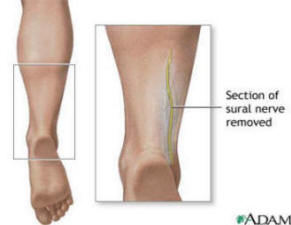CIDPUSA.ORG ❤
Autoimmune Diseases Web
Diagnostic value of sural nerve biopsy in chronic inflammatory demyelinating polyneuropathy

Correspondence to: Dr DSM Molenaar, Department of Neurology (H2-214), Academic Medical Center, PO Box 22700, 1100 DE Amsterdam, The Netherlands. Telephone 0031 20 5663546; fax 0031 20 6971438;
Received 19 May 1997 and in revised form 22 July 1997; Accepted 29 July 1997
OBJECTIVETo
investigate the additional diagnostic value of sural nerve biopsy of 64 patients in whom chronic inflammatory demyelinating polyneuropathy (CIDP) was considered, as sural nerve biopsy is
recommended in the research criteria of an ad hoc subcommitteeto diagnose CIDP.
METHODSFirstly,
the additional diagnostic value of sural nerve biopsy was analysed with multivariate logistic re- gression. Six clinical features (remitting course, symmetric sensorimotor neuropathy
in arms and legs, areflexia, raised CSF protein concentration,nerve conduction studies consistent with demyelination, and absence of comorbidity or relevant laboratory
abnormalities) were entered into a logistic model. Afterwards, all significant features identified from this model, as well as the results of sural nerve biopsy were
forced into a second logistic model. Secondly, the diagnosticperformance of a neurologist experienced in diagnosis of peripheral nerve disorders was studied by receiver
operating characteristics (ROC) curve analysis.
RESULTSThe results of the first logistic analysis showed that CSF protein
concentration >1 g/l (odds ratio (OR)=38.5) and neurophysiologicalstudies consistent with demyelination (OR=51.7) were strong predictors of CIDP. When forcing the significant features
and the sural nerve biopsy data into the model, an independent predictive value of sural nerve biopsy could not be found. The neurologist was able to discriminate
patients with and without CIDP (area under the curve (AUC)=0.95). His diagnostic performance did not improve significantly by offering him the results of sural nerve
biopsy.
CONCLUSIONAny additional diagnostic value of sural nerve biopsy in the diagnosis of CIDP could not be shown.
(J Neurol Neurosurg Psychiatry 1998;64:84-89)
Keywords: chronic inflammatory demyelinating polyneuropathy; sural nerve biopsy
Sural nerve biopsy is considered to be a valuable method for establishing the cause of peripheral neuropathies in specificcircumstances, if it is evaluated by a neuropathologist experienced in modern techniques. It is indicated in a few patients with peripheral neuropathy and should be done only after careful clinical,laboratory, and neurophysiological evaluation.Whether suspected chronic inflammatory demyelinating polyneuropathy (CIDP) is an indication for sural nerve biopsy studies remains inconclusive from reports in the literature. Argov et al, for instance, suggest that sural nerve biopsy should be reserved for patients with a clinical picture of polyneuropathy and electrodiagnostic criteria suggestive of demyelination. Asbury, however, recommends the use of sural nerve biopsy only in cases of a clinical picture of mononeuritis multiplex, enlarged nerves at palpation, or for establishing diagnosis in genetically determined paediatric disorders. Sural nerve biopsy studies have been reported in several series of patients with CIDP. The abnormalities found are often not specific for CIDP On the other hand, sural nerve biopsy is a requisite for diagnosis of "definite" CIDP according to the research criteriafor diagnosis of CIDP of the ad hoc subcommittee, published in1990.
Other tests to diagnose CIDP include lumbar puncture, withdrawal of blood, and neurophysiological tests. Sural nerve biopsyis the most invasive procedure of all these procedures and should be considered after the results of the other tests are known.However, little is known about the diagnostic properties of sural nerve biopsy in CIDP. Therefore, the objectives of this study were (1) to investigate the objective additional diagnostic value of sural nerve biopsy in CIDP, given the results of the clinical picture, and laboratory and neurophysiological tests, and (2) to assess to what extent the diagnostic performance of an experienced neurologist was influenced by the results of sural nervebiopsy.
Please continue to sural nerve biopsy on
next page
Links
- Home
- FAQ
- CONTACT SERVICES
- IVIG
- MMN guide
- Autonomic
- CIDP Tips
- ALS
- Lewis Sumner
- Most diabetic neuropathy is CIDP
- Axonal Polyneuropathy changes in EMG
- Learn about
- EMG/NCV section
- Axonal Polyneuropathy changes in EMG
- Services link
- Zapper
- Magnet therpay
- Small Fiber neuropathy
- neurological effects of CIDP